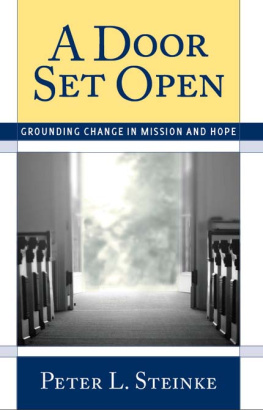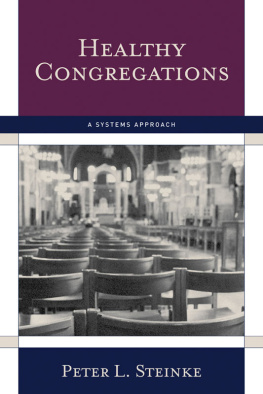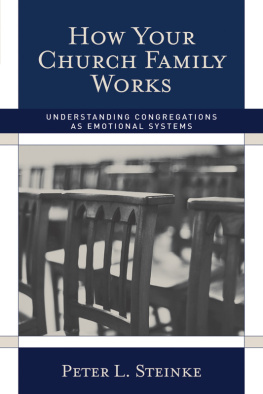A Door Set Open
Grounding Change in Mission and Hope
Peter L. Steinke
The Alban Institute
Herndon, Virginia
www.alban.org
Copyright 2010 by The Alban Institute. All rights reserved. This material may not be photocopied or reproduced in any way without written permission. Go to www.alban.org/permissions.asp or write to The Alban Institute, 2121 Cooperative Way, Suite 100, Herndon, VA 20171.
All scripture quotations, unless otherwise indicated, are taken from the Holy Bible, New International Version, NIV. Copyright 1973, 1978, 1984 by Biblica, Inc. Used by permission of Zondervan. All rights reserved worldwide.
Cartoons courtesy of Raymond Johnson. Used with Permission.
Cover design by Tobias Becker, Bird Box Design.
Cover photo by Krista Steinke.
Library of Congress Cataloging-in-Publication Data
Steinke, Peter L. A door set open : grounding change in mission and hope / Peter L. Steinke.
p. cm. Includes bibliographical references (p. 135). ISBN 978-1-56699-403-3
1. Church renewal. 2. Mission of the church. 3. Hope--Religious aspects
--Christianity. 4. System theory. I. Title. BV600.3.S736 2010 262.0017--dc22
2010021121
GOOD NEWS: but if you ask me what it is, I know not; It is a track of feet in the snow, It is a lantern showing a path, It is a door set open.
G. K. Chesterton,
Xmas Day
Contents
I first met Pete Steinke in the fall of 2000 while I was serving as pastor of the Amagansett Presbyterian Church on Long Island, New York. I attended a presbytery-sponsored family systems training event that Pete led called Bridge Builders. I later took his additional training, Healthy Congregations. At that time I had no idea that our lives would intersect in a profound way in the future.
Since I held a ThD in clinical pastoral counseling, was a Fellow in the American Association of Pastoral Counselors, and practiced for many years as a pastoral counselor, I came to the conference with a high level of curiosity about what Pete would have to offer regarding how family systems theory might help both conflicted and healthy churches become healthier.
Although already well acquainted with Murray Bowen and Edwin Friedmans work, I had never seen anyone apply family systems principles to faith communities in any concrete, practical, and systematic way before. Petes seminar took the top of my head off, and I was never the same again. I had finally met a pastor, theologian, and clinical practitioner who really knew the theory and had crafted a vision and practical plan to equip conflicted congregations and their leaders to negotiate the troubled waters of their ecclesial lives and also help nonconflicted churches become healthier.
Pete has been involved in more than two hundred interventions in conflicted churches across the United States in diverse denominational and cultural settings. He has also consulted with several seminaries, from which he has gleaned an unprecedented wealth of experience and knowledge.
In 2003 I was called to be the director of Austin Presbyterian Theological Seminarys Doctor of Ministry program. Remembering that Pete lived in Austin, I contacted him and an endearing friendship began. He gives a three-hour lecture in each of my doctoral seminars, and his three previous books are required reading in my doctoral methods seminar. Students find his books to be invaluable, and he has helped me see that systemic assessment of each congregation must be required in all of our Doctor of Ministry final project proposals.
I later became president of the Association for Doctor of Ministry Education (ADME), an association that represents the 145 Association of Theological Schools accredited DMin programs in North America, and our board invited Pete to be the keynote speaker for our 2008 annual convention. Our DMin directors were quite taken with Petes lectures, and he received several invitations to teach DMin courses in various seminaries.
Hearing Pete speak, both in formal lectures and in numerous informal conversations, I saw this current book percolating in him because he kept referencing a salient theme emerging in his workmission. Pete has rightly identified one of the most significant markers of any healthy congregationa vision and passion for mission. And likewise, he notes how the inverse is equally trueunhealthy churches are usually consumed by anxiety, which causes them to become unduly rigid, self-serving, and inwardly focused.
In this book you will benefit from Petes extensive inside knowledge of working with both conflicted and healthy congregations as he makes the case that becoming a mission-focused church will improve the systemic health of a congregation. You will find his practical examples both helpful and challenging, his masterful storytelling intriguing, and his theological reflection on the inextricable connections between a biblical commitment to mission and ecclesial systemic health prophetic.
David Jones, ThD
Doctor of Ministry Director
Austin Presbyterian Theological Seminary
A book is a system. Many parts come together and interact to make a whole. I want to thank Beth Ann Gaede and Andrea Lee for their editorial skills and personal patience; their questions, corrections, and suggestions have increased the quality of the content. Serena Verzhinsky should be equally applauded for typing the manuscript. I write in the old-fashioned way, with paper on the table and pen in hand. To decipher my handwriting is a significant task.
Numerous unnamed people from churches in several dozen states and a dozen denominations are contributors. They worked with me in making changes in their congregations. Watching their commitment to the change process and their indefatigable efforts to shift the functioning of their congregations, I marveled. Even the doubters and the fearful ones were instructors, reinforcing the idea of how strong emotional forces can be.
I am grateful to the parish pastors who patiently listened to my insights and compared them to their own situations, namely Bill Knippa, Paul Meyer, Roger Schwarze, Dick Smith, and Bill Snyder. David Jones, president of ADME (Association for Doctor of Ministry Education) offered insight. The wisdom of two judicatory leaders, Debra Rundlett and Cherlynne Beck, helped me see from another angle. My appreciation is deep for the partnership that has formed between Jon Lee, Paul Blom, and myself. They will assist me in a new ventureNEW VISIONSin which this book will be vital. New Visions: Leadership for Mission is a training effort to complement the work of church leaders in creating a greater consciousness about mission and broadening the congregations mission activity.
Finally, I thank my wife, Kelly, who listened to my Ahas! and challenged my line of thought. What a system!
I have written this book to encourage and shape a conversation about the churchs future in todays world of change and challenge. The first influence on my thinking has been my experience working with churches (1) engaged in conflict, (2) caught in a stubborn impasse, (3) entering a phase of transition, or (4) wanting to sustain a level of effective functioning. Having consulted with more than two hundred churches in eight denominations, ranging in membership from one hundred to six thousand, located in different population areas, I have witnessed both meager efforts and impressive responses to the challenges provoked by change. I will share what I have observed with you.
All congregations are facing challenges brought about by rapid change. But their responses vary greatly, from slight adjustments to surprising adaptations. Why? The late Edwin Friedman, Bowen systems theory advocate and my mentor, used the formula HE = RO. Essentially, the formula is shorthand for this rule of thumb:
Next page












